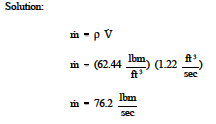

If the size of the pipe is constant, the flow rate of the fluid with a large flow rate is of course also large the pressure loss (i.e. If the fluid is a gas (compressibility), the flow rate is constant, and the flow rate of a gas with high pressure is of course also large. That is: the flow rate multiplied by the pipe cross-sectional area equals the flow rate. The unit is: the flow rate per unit area (internal section of the pipeline). It is the average velocity of fluid flowing in the pipe. Here, there is another important parameter: flow rate. The flow rate is the amount (weight or volume) of the fluid flowing through the pipe per unit time. For fluids with high pressure, the flow rate can be high or low.Įngineering pressure is the amount of force per unit area. The fluid pressure and flow rate in the pipeline are completely two concepts. Video source: Volume flow unit converter Unit The following video provides a good explanation. That is, to convert the volume flow of air into a mass flow, multiply the coefficient by 1.29.Ĭonverter Tool: Volumetric Flow Rate & Pipe Diameter to Flow Speed Calculator Density, Mass Flow, and Volumetric FlowĪ description of the relationship between density, mass flow rate, and volumetric flow rate. Then the volume flow rate of the air qv=V/t (cubic meters/hour), and the mass flow rate qm=m/t (kg/hour).Īnd because air quality = air density x air volume, m = ρV = 1.29V. Solution: Let the mass of air passing in t hours be m kg, the volume be V cubic meters, and the known air density ρ = 1.29 kg/m3. That is, to convert the volume flow of air into the mass flow, multiply the coefficient by 1.29. The conversion factor between air volume flow rate and air volume flow rate is 1.29.
VOLUMETRIX FLOW RATE TO MASS FLOW HOW TO
How to convert air volume flow to air mass flow?

In the formula: qv is the volume flow, m3/s. The volume flow is expressed by the formula: qv=V/t=u×A. The volume flow rate is the flow rate expressed by the volume of the fluid quantity. Flow is divided into volume flow and mass flow.


 0 kommentar(er)
0 kommentar(er)
